Personal Reflection on Nursing: Healthcare Experience
VerifiedAdded on 2023/01/11
|6
|1659
|72
Essay
AI Summary
This essay presents a personal reflection on a nursing experience in an overseas hospital, analyzed using the Gibbs reflective model. The student describes an uncomfortable experience, including poor hospital conditions, a language barrier with the doctor, and a lack of patient privacy and dignity. The essay explores feelings of frustration, anger, and a realization of the importance of quality healthcare. The evaluation highlights issues such as overcrowding, lack of privacy, and poor hygiene. The analysis connects the experience to Florence Nightingale's environmental theory and the importance of cultural competence. The conclusion emphasizes the need for improved clinical skills, cultural sensitivity, and staff attitudes. The action plan proposes training for medical staff on patient engagement, communication, and cultural competence, along with administrative changes to improve hospital standards and address language barriers.
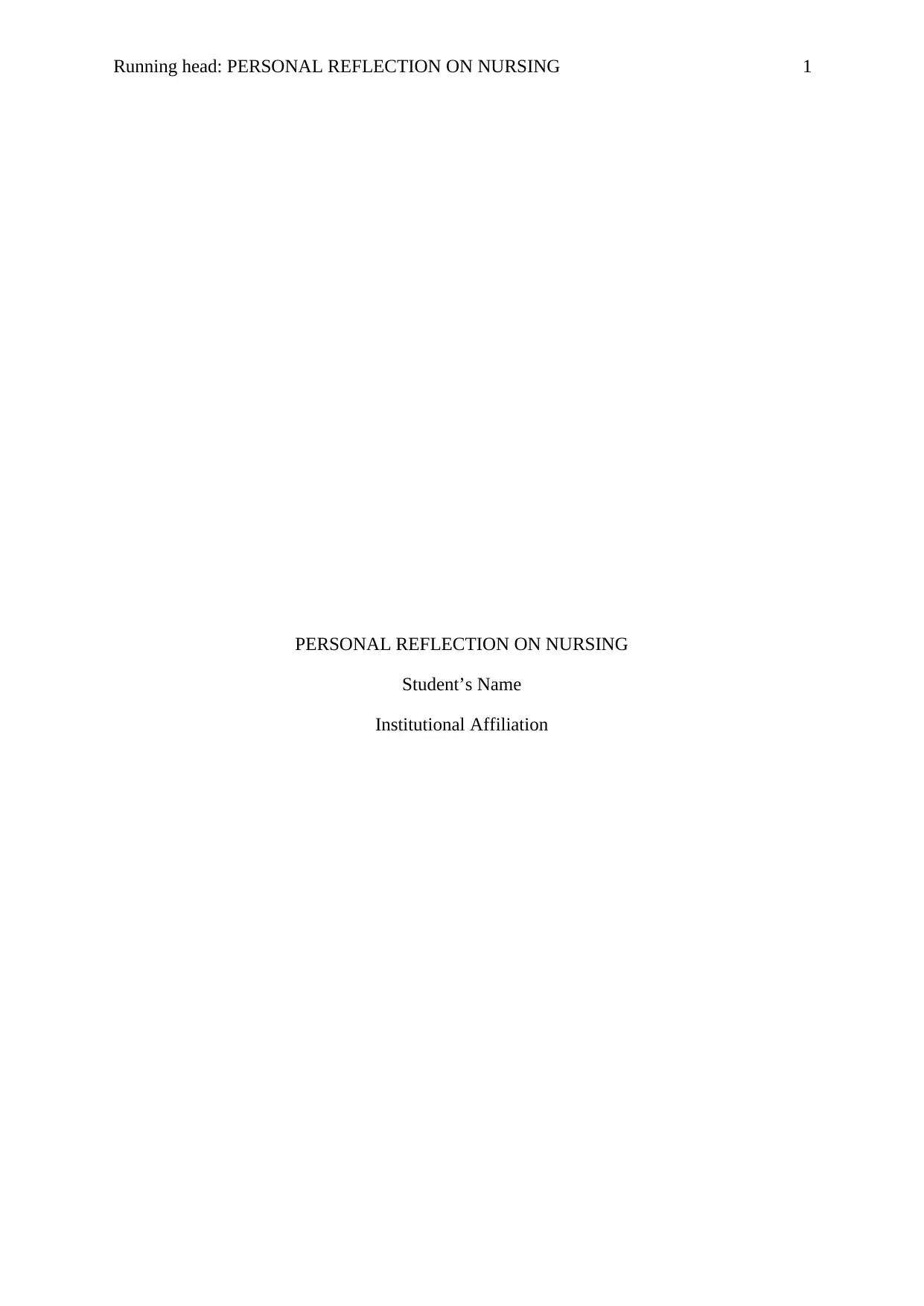
Running head: PERSONAL REFLECTION ON NURSING 1
PERSONAL REFLECTION ON NURSING
Student’s Name
Institutional Affiliation
PERSONAL REFLECTION ON NURSING
Student’s Name
Institutional Affiliation
Paraphrase This Document
Need a fresh take? Get an instant paraphrase of this document with our AI Paraphraser
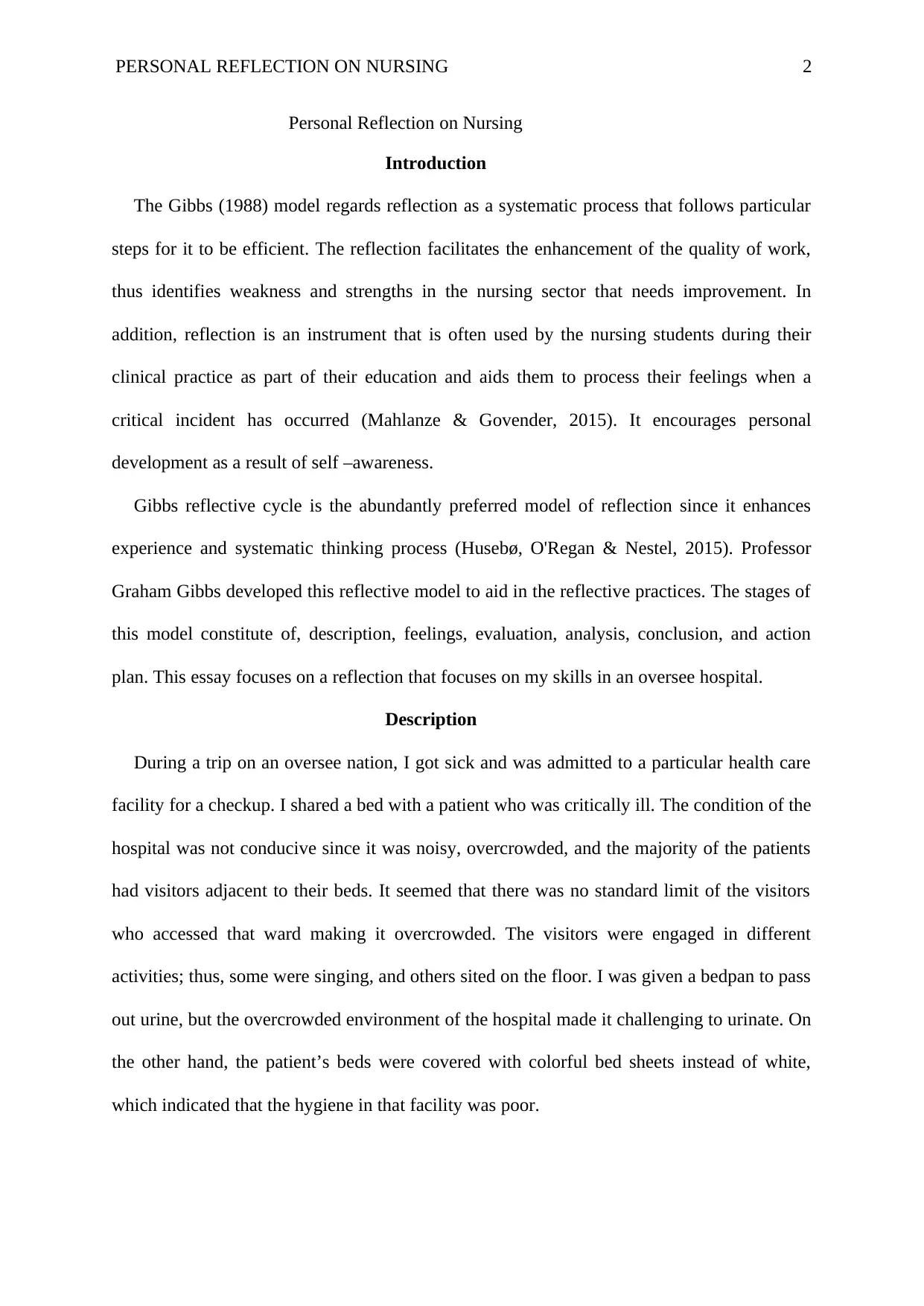
PERSONAL REFLECTION ON NURSING 2
Personal Reflection on Nursing
Introduction
The Gibbs (1988) model regards reflection as a systematic process that follows particular
steps for it to be efficient. The reflection facilitates the enhancement of the quality of work,
thus identifies weakness and strengths in the nursing sector that needs improvement. In
addition, reflection is an instrument that is often used by the nursing students during their
clinical practice as part of their education and aids them to process their feelings when a
critical incident has occurred (Mahlanze & Govender, 2015). It encourages personal
development as a result of self –awareness.
Gibbs reflective cycle is the abundantly preferred model of reflection since it enhances
experience and systematic thinking process (Husebø, O'Regan & Nestel, 2015). Professor
Graham Gibbs developed this reflective model to aid in the reflective practices. The stages of
this model constitute of, description, feelings, evaluation, analysis, conclusion, and action
plan. This essay focuses on a reflection that focuses on my skills in an oversee hospital.
Description
During a trip on an oversee nation, I got sick and was admitted to a particular health care
facility for a checkup. I shared a bed with a patient who was critically ill. The condition of the
hospital was not conducive since it was noisy, overcrowded, and the majority of the patients
had visitors adjacent to their beds. It seemed that there was no standard limit of the visitors
who accessed that ward making it overcrowded. The visitors were engaged in different
activities; thus, some were singing, and others sited on the floor. I was given a bedpan to pass
out urine, but the overcrowded environment of the hospital made it challenging to urinate. On
the other hand, the patient’s beds were covered with colorful bed sheets instead of white,
which indicated that the hygiene in that facility was poor.
Personal Reflection on Nursing
Introduction
The Gibbs (1988) model regards reflection as a systematic process that follows particular
steps for it to be efficient. The reflection facilitates the enhancement of the quality of work,
thus identifies weakness and strengths in the nursing sector that needs improvement. In
addition, reflection is an instrument that is often used by the nursing students during their
clinical practice as part of their education and aids them to process their feelings when a
critical incident has occurred (Mahlanze & Govender, 2015). It encourages personal
development as a result of self –awareness.
Gibbs reflective cycle is the abundantly preferred model of reflection since it enhances
experience and systematic thinking process (Husebø, O'Regan & Nestel, 2015). Professor
Graham Gibbs developed this reflective model to aid in the reflective practices. The stages of
this model constitute of, description, feelings, evaluation, analysis, conclusion, and action
plan. This essay focuses on a reflection that focuses on my skills in an oversee hospital.
Description
During a trip on an oversee nation, I got sick and was admitted to a particular health care
facility for a checkup. I shared a bed with a patient who was critically ill. The condition of the
hospital was not conducive since it was noisy, overcrowded, and the majority of the patients
had visitors adjacent to their beds. It seemed that there was no standard limit of the visitors
who accessed that ward making it overcrowded. The visitors were engaged in different
activities; thus, some were singing, and others sited on the floor. I was given a bedpan to pass
out urine, but the overcrowded environment of the hospital made it challenging to urinate. On
the other hand, the patient’s beds were covered with colorful bed sheets instead of white,
which indicated that the hygiene in that facility was poor.
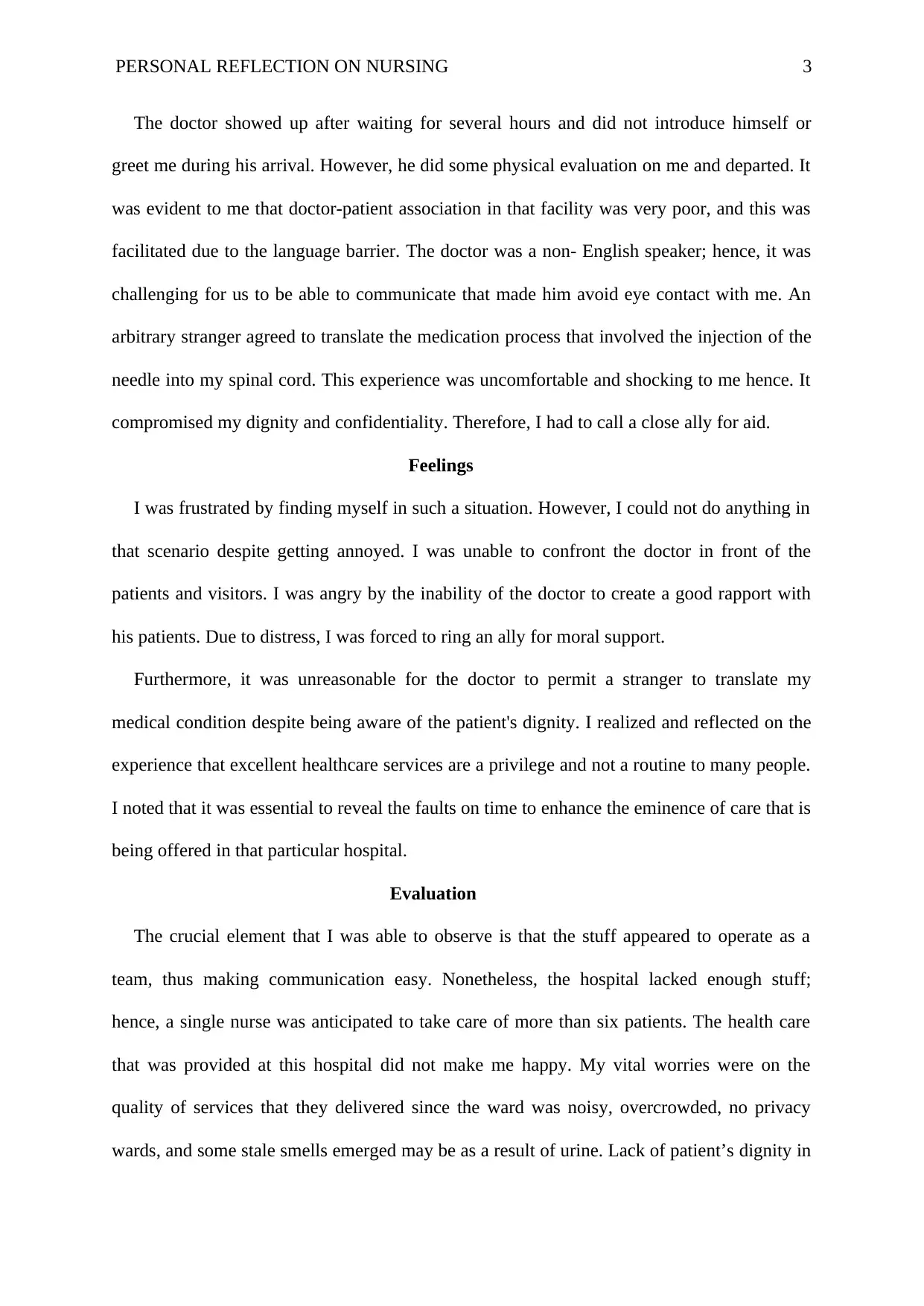
PERSONAL REFLECTION ON NURSING 3
The doctor showed up after waiting for several hours and did not introduce himself or
greet me during his arrival. However, he did some physical evaluation on me and departed. It
was evident to me that doctor-patient association in that facility was very poor, and this was
facilitated due to the language barrier. The doctor was a non- English speaker; hence, it was
challenging for us to be able to communicate that made him avoid eye contact with me. An
arbitrary stranger agreed to translate the medication process that involved the injection of the
needle into my spinal cord. This experience was uncomfortable and shocking to me hence. It
compromised my dignity and confidentiality. Therefore, I had to call a close ally for aid.
Feelings
I was frustrated by finding myself in such a situation. However, I could not do anything in
that scenario despite getting annoyed. I was unable to confront the doctor in front of the
patients and visitors. I was angry by the inability of the doctor to create a good rapport with
his patients. Due to distress, I was forced to ring an ally for moral support.
Furthermore, it was unreasonable for the doctor to permit a stranger to translate my
medical condition despite being aware of the patient's dignity. I realized and reflected on the
experience that excellent healthcare services are a privilege and not a routine to many people.
I noted that it was essential to reveal the faults on time to enhance the eminence of care that is
being offered in that particular hospital.
Evaluation
The crucial element that I was able to observe is that the stuff appeared to operate as a
team, thus making communication easy. Nonetheless, the hospital lacked enough stuff;
hence, a single nurse was anticipated to take care of more than six patients. The health care
that was provided at this hospital did not make me happy. My vital worries were on the
quality of services that they delivered since the ward was noisy, overcrowded, no privacy
wards, and some stale smells emerged may be as a result of urine. Lack of patient’s dignity in
The doctor showed up after waiting for several hours and did not introduce himself or
greet me during his arrival. However, he did some physical evaluation on me and departed. It
was evident to me that doctor-patient association in that facility was very poor, and this was
facilitated due to the language barrier. The doctor was a non- English speaker; hence, it was
challenging for us to be able to communicate that made him avoid eye contact with me. An
arbitrary stranger agreed to translate the medication process that involved the injection of the
needle into my spinal cord. This experience was uncomfortable and shocking to me hence. It
compromised my dignity and confidentiality. Therefore, I had to call a close ally for aid.
Feelings
I was frustrated by finding myself in such a situation. However, I could not do anything in
that scenario despite getting annoyed. I was unable to confront the doctor in front of the
patients and visitors. I was angry by the inability of the doctor to create a good rapport with
his patients. Due to distress, I was forced to ring an ally for moral support.
Furthermore, it was unreasonable for the doctor to permit a stranger to translate my
medical condition despite being aware of the patient's dignity. I realized and reflected on the
experience that excellent healthcare services are a privilege and not a routine to many people.
I noted that it was essential to reveal the faults on time to enhance the eminence of care that is
being offered in that particular hospital.
Evaluation
The crucial element that I was able to observe is that the stuff appeared to operate as a
team, thus making communication easy. Nonetheless, the hospital lacked enough stuff;
hence, a single nurse was anticipated to take care of more than six patients. The health care
that was provided at this hospital did not make me happy. My vital worries were on the
quality of services that they delivered since the ward was noisy, overcrowded, no privacy
wards, and some stale smells emerged may be as a result of urine. Lack of patient’s dignity in
⊘ This is a preview!⊘
Do you want full access?
Subscribe today to unlock all pages.

Trusted by 1+ million students worldwide

PERSONAL REFLECTION ON NURSING 4
a medical specialist is a frustrating and dehumanizing experience. On that note, I mingled
with three medical stuffs that were uncaring and cold.
Analysis
I believe that the primary purposes for the development of the health care systems are
stimulating and supporting the healing of patients. Peoples association and the surrounding
circumstances elaborate a productive healing environment. The healing of human beings
involves the body, amid and spirit. Physical environment often influences patients
individually. Florence Nightingale environmental theory justifies these facts. In regards to the
theory, the disease is a process of health restoration, and the pieces of stuff have a vital role in
maintaining the external and internal environments to recovery quickly from the infection
(Nestel & Bearman, 2015). The suitable environment includes appropriate control of heat,
ventilation, noise, proper lighting, and free from bad smell. Privacy and space is another
crucial aspect that needs to be considered. The analysis that I obtained is that the hospital was
dirty and overcrowded. In addition, there were poor spacing amid the beds; hence, it was too
small to accommodate the patients efficiently. It lacked proper restrictions noises made by the
visitors and control of the lighting systems.
Cultural and language barrier is another challenge that was evident in the hospital. Based
on my understanding and knowledge, no evaluation was done; hence, they did not make
inquiries on my beliefs or values. The health stuff appeared to be disinterested and distant on
the issue regarding the patient's beliefs. The medical practitioners should be aware that
culture plays a significant role in determining the patient’s outcome, furthermore developing
quality care (Oluwatoyin, 2015). Culture comprises of shared values, beliefs, traditions, and
language in some scenarios. An encounter with a patient is a chance to be able to understand
and learn a different culture which can be incorporated into the patients’ healthcare plan.
a medical specialist is a frustrating and dehumanizing experience. On that note, I mingled
with three medical stuffs that were uncaring and cold.
Analysis
I believe that the primary purposes for the development of the health care systems are
stimulating and supporting the healing of patients. Peoples association and the surrounding
circumstances elaborate a productive healing environment. The healing of human beings
involves the body, amid and spirit. Physical environment often influences patients
individually. Florence Nightingale environmental theory justifies these facts. In regards to the
theory, the disease is a process of health restoration, and the pieces of stuff have a vital role in
maintaining the external and internal environments to recovery quickly from the infection
(Nestel & Bearman, 2015). The suitable environment includes appropriate control of heat,
ventilation, noise, proper lighting, and free from bad smell. Privacy and space is another
crucial aspect that needs to be considered. The analysis that I obtained is that the hospital was
dirty and overcrowded. In addition, there were poor spacing amid the beds; hence, it was too
small to accommodate the patients efficiently. It lacked proper restrictions noises made by the
visitors and control of the lighting systems.
Cultural and language barrier is another challenge that was evident in the hospital. Based
on my understanding and knowledge, no evaluation was done; hence, they did not make
inquiries on my beliefs or values. The health stuff appeared to be disinterested and distant on
the issue regarding the patient's beliefs. The medical practitioners should be aware that
culture plays a significant role in determining the patient’s outcome, furthermore developing
quality care (Oluwatoyin, 2015). Culture comprises of shared values, beliefs, traditions, and
language in some scenarios. An encounter with a patient is a chance to be able to understand
and learn a different culture which can be incorporated into the patients’ healthcare plan.
Paraphrase This Document
Need a fresh take? Get an instant paraphrase of this document with our AI Paraphraser
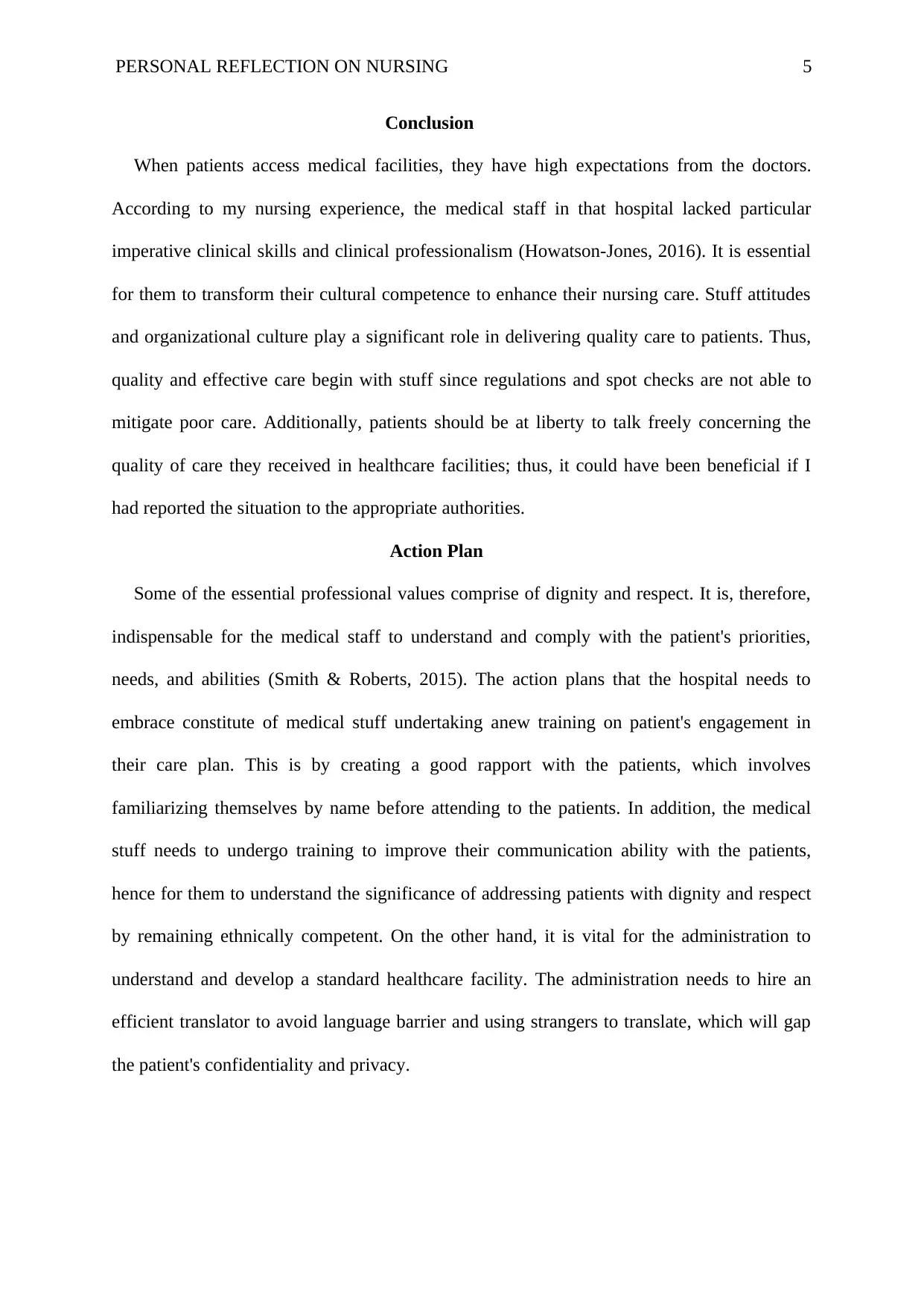
PERSONAL REFLECTION ON NURSING 5
Conclusion
When patients access medical facilities, they have high expectations from the doctors.
According to my nursing experience, the medical staff in that hospital lacked particular
imperative clinical skills and clinical professionalism (Howatson-Jones, 2016). It is essential
for them to transform their cultural competence to enhance their nursing care. Stuff attitudes
and organizational culture play a significant role in delivering quality care to patients. Thus,
quality and effective care begin with stuff since regulations and spot checks are not able to
mitigate poor care. Additionally, patients should be at liberty to talk freely concerning the
quality of care they received in healthcare facilities; thus, it could have been beneficial if I
had reported the situation to the appropriate authorities.
Action Plan
Some of the essential professional values comprise of dignity and respect. It is, therefore,
indispensable for the medical staff to understand and comply with the patient's priorities,
needs, and abilities (Smith & Roberts, 2015). The action plans that the hospital needs to
embrace constitute of medical stuff undertaking anew training on patient's engagement in
their care plan. This is by creating a good rapport with the patients, which involves
familiarizing themselves by name before attending to the patients. In addition, the medical
stuff needs to undergo training to improve their communication ability with the patients,
hence for them to understand the significance of addressing patients with dignity and respect
by remaining ethnically competent. On the other hand, it is vital for the administration to
understand and develop a standard healthcare facility. The administration needs to hire an
efficient translator to avoid language barrier and using strangers to translate, which will gap
the patient's confidentiality and privacy.
Conclusion
When patients access medical facilities, they have high expectations from the doctors.
According to my nursing experience, the medical staff in that hospital lacked particular
imperative clinical skills and clinical professionalism (Howatson-Jones, 2016). It is essential
for them to transform their cultural competence to enhance their nursing care. Stuff attitudes
and organizational culture play a significant role in delivering quality care to patients. Thus,
quality and effective care begin with stuff since regulations and spot checks are not able to
mitigate poor care. Additionally, patients should be at liberty to talk freely concerning the
quality of care they received in healthcare facilities; thus, it could have been beneficial if I
had reported the situation to the appropriate authorities.
Action Plan
Some of the essential professional values comprise of dignity and respect. It is, therefore,
indispensable for the medical staff to understand and comply with the patient's priorities,
needs, and abilities (Smith & Roberts, 2015). The action plans that the hospital needs to
embrace constitute of medical stuff undertaking anew training on patient's engagement in
their care plan. This is by creating a good rapport with the patients, which involves
familiarizing themselves by name before attending to the patients. In addition, the medical
stuff needs to undergo training to improve their communication ability with the patients,
hence for them to understand the significance of addressing patients with dignity and respect
by remaining ethnically competent. On the other hand, it is vital for the administration to
understand and develop a standard healthcare facility. The administration needs to hire an
efficient translator to avoid language barrier and using strangers to translate, which will gap
the patient's confidentiality and privacy.
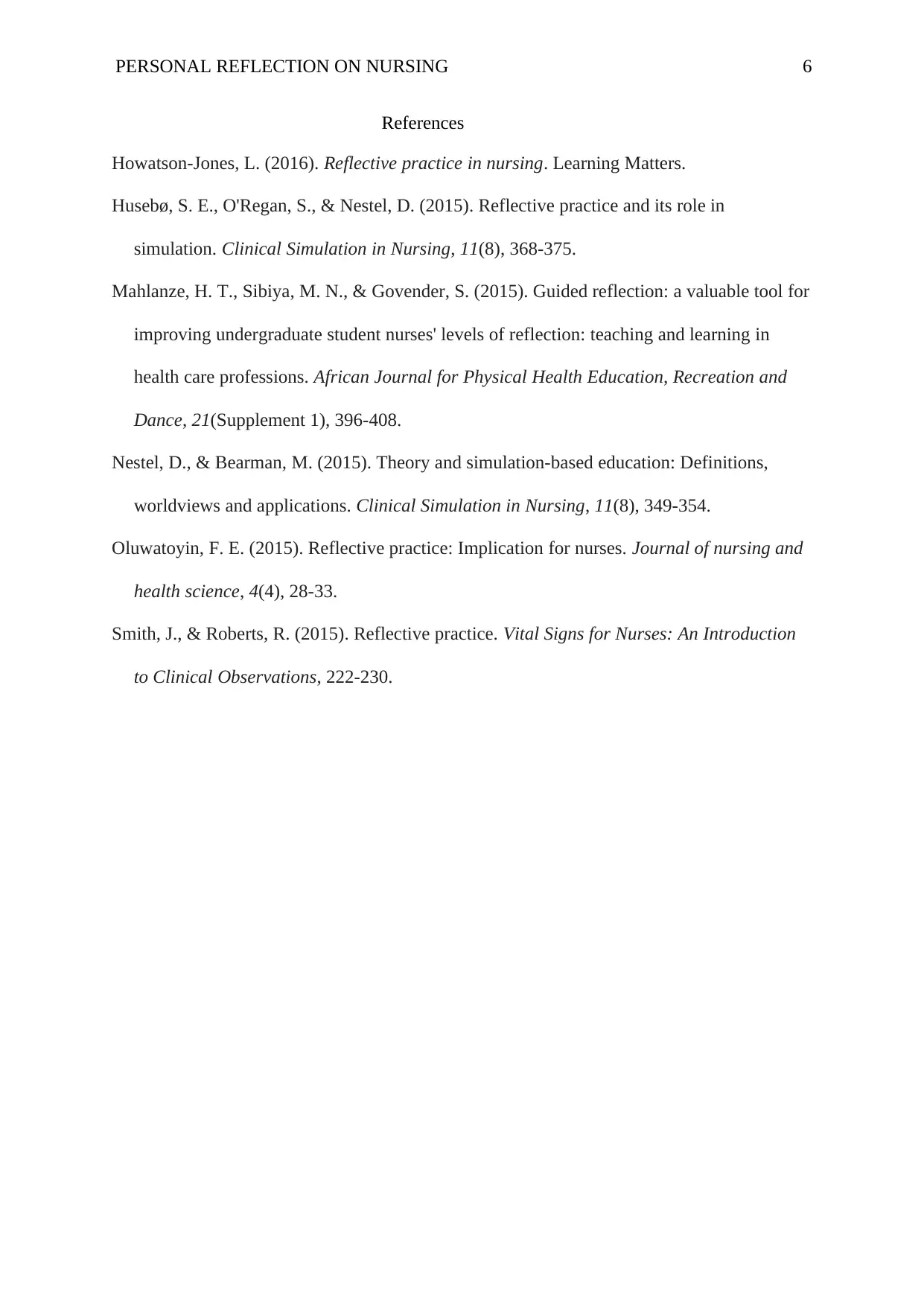
PERSONAL REFLECTION ON NURSING 6
References
Howatson-Jones, L. (2016). Reflective practice in nursing. Learning Matters.
Husebø, S. E., O'Regan, S., & Nestel, D. (2015). Reflective practice and its role in
simulation. Clinical Simulation in Nursing, 11(8), 368-375.
Mahlanze, H. T., Sibiya, M. N., & Govender, S. (2015). Guided reflection: a valuable tool for
improving undergraduate student nurses' levels of reflection: teaching and learning in
health care professions. African Journal for Physical Health Education, Recreation and
Dance, 21(Supplement 1), 396-408.
Nestel, D., & Bearman, M. (2015). Theory and simulation-based education: Definitions,
worldviews and applications. Clinical Simulation in Nursing, 11(8), 349-354.
Oluwatoyin, F. E. (2015). Reflective practice: Implication for nurses. Journal of nursing and
health science, 4(4), 28-33.
Smith, J., & Roberts, R. (2015). Reflective practice. Vital Signs for Nurses: An Introduction
to Clinical Observations, 222-230.
References
Howatson-Jones, L. (2016). Reflective practice in nursing. Learning Matters.
Husebø, S. E., O'Regan, S., & Nestel, D. (2015). Reflective practice and its role in
simulation. Clinical Simulation in Nursing, 11(8), 368-375.
Mahlanze, H. T., Sibiya, M. N., & Govender, S. (2015). Guided reflection: a valuable tool for
improving undergraduate student nurses' levels of reflection: teaching and learning in
health care professions. African Journal for Physical Health Education, Recreation and
Dance, 21(Supplement 1), 396-408.
Nestel, D., & Bearman, M. (2015). Theory and simulation-based education: Definitions,
worldviews and applications. Clinical Simulation in Nursing, 11(8), 349-354.
Oluwatoyin, F. E. (2015). Reflective practice: Implication for nurses. Journal of nursing and
health science, 4(4), 28-33.
Smith, J., & Roberts, R. (2015). Reflective practice. Vital Signs for Nurses: An Introduction
to Clinical Observations, 222-230.
⊘ This is a preview!⊘
Do you want full access?
Subscribe today to unlock all pages.

Trusted by 1+ million students worldwide
1 out of 6
Related Documents
Your All-in-One AI-Powered Toolkit for Academic Success.
+13062052269
info@desklib.com
Available 24*7 on WhatsApp / Email
![[object Object]](/_next/static/media/star-bottom.7253800d.svg)
Unlock your academic potential
Copyright © 2020–2025 A2Z Services. All Rights Reserved. Developed and managed by ZUCOL.




